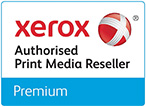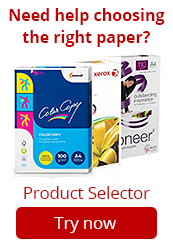Hints and Tips
Time saving tips: Consider using an Express Box (BulkBox) If you are printing a large number of copies, consider using paper supplied in an Express Box; 2500 sheets in a carton with no ream wrappers. As well as being easy to load into your copier, there is less waste and hassle with ream wrappers. Ideal for speed and convenience when high volume printing and copying. |
||||||||||
| Time saving tips: Consider using pre-punched paper Why not use a pre-punched paper when producing copies of reports? A number of our papers are available already punched with 4 holes. As well as the convenience of not having to punch the paper after printing, there is also the added advantage of no waste from the punching! No more worries about alignment of the holes. Ideal for the quick and easy collation of bound reports and documents - save time and hassle. |
||||||||||
| Tinted papers: Improve office efficiency or create striking report documents Why not use pastel coloured (tinted) paper to help colour co-ordinate your documents – making it easy to recognise the source of a document or its importance. The perfect choice for colour-coding your faxes, memos, customer records, important documents, bulletins etc. Coloured paper makes your documents instantly recognisable, improving office efficiency. As a bonus this also helps to brighten up your office environment. Furthermore, Reports when produced with different coloured sections will become striking and easily navigable. |
||||||||||
| Tinted papers: Create high-impact notices and posters etc Why not use bold tinted papers for eye-catching posters, flyers, notices, brochures, important documents and bulletins. The A3 sizes are particularly suitable for creating high-impact posters and notices. |
||||||||||
| Getting the best performance: Problems associated with temperature Paper is very sensitive to temperature and great care should be taken during transportation, storage and use to equalise the temperature of the paper and the printing environment before unwrapping. If cold paper is unwrapped before its temperature equalises with that of a warm printing environment, the air condenses and is quickly absorbed by the paper. This may result in jamming and poor print quality. We recommend the following equalisation times for a pallet of paper:
|
||||||||||
Getting the best performance: Problems associated with humidity Variations between the humidity of the paper and the printing environment can cause similar problems of jamming and print quality. Any moisture in the air will be absorbed by the paper the moment it is unwrapped and with copiers and laser printers operating at such high temperatures, they are most susceptible to the resultant problems. Remember to keep paper in its moisture proof wrapping until it is to be used. The opposite but less common problem, especially in the winter months, is caused by low humidity in the printing environment, relative to the storage area. The material gives off moisture as it is unwrapped and the fibres contract, mainly in the cross-grain direction. Keep the machine area dry and leave the paper there for some time before using, to allow it to stabilise. Humidity problems with laser printers and copiers include: Too high – a higher moisture content in the paper causes ‘dirty’ images as the paper picks up additional toner, while excessive evaporation can cause the paper to lose shape and warp, resulting in misfeeding. Excessive moisture can also lower the machine temperature which reduces the effectiveness of toner fixing. Too low – if the moisture content is too low, jamming can occur as the paper may stick to the charge drum. |
||||||||||
| Getting the best performance: Reducing jam rates Fanning the paper and 'knocking up' the edges so that they are all aligned can help to prevent mis-feeds and jams. The paper stack should always be flat and with the edges aligned. However if you have not read and followed the advice in the 2 performance hints directly above then this method may not work in isolation. |
||||||||||
| Getting the best results: Colour printing When producing a document with colour images, use a paper specifically designed for colour printing. As well as more impressive print results, you will also use less toner. |
||||||||||
| Getting the best results: Photo printing When printing out a high quality photographic image, why not print a draft copy onto a cheaper paper first, so that you can check the positioning on the page, etc, rather than risk wasting a more expensive sheet of photo quality paper. |
||||||||||
| Getting the best results: Matching the paper to the equipment Try to use a paper designed for the equipment that you are using – you will get a better result and it will be more cost-effective in the long term because there will be fewer jams, less risk of poor print quality and therefore less waste of paper overall and as an added bonus your toner / print cartridges should last longer. |
||||||||||
|
|
||||||||||
Purelypaper Ltd provides all information in good faith but may not be held liable for loss or damage arising from action based on these Buying Guides. Copyright Notice: The materials and information on www.purelypaper.co.uk and of www.purelypaper.co.uk and their style and structure are protected by copyright and other intellectual property rights, and may not be used by you except as expressly provided in our User Agreement. |






